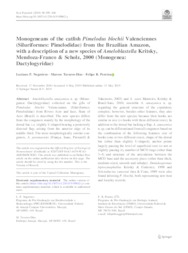Monogeneans of the catfish Pimelodus blochii Valenciennes (Siluriformes: Pimelodidae) from the Brazilian Amazon, with a description of a new species of Ameloblastella Kritsky, Mendoza-Franco & Scholz, 2000 (Monogenea: Dactylogyridae).
Monogeneans of the catfish Pimelodus blochii Valenciennes (Siluriformes: Pimelodidae) from the Brazilian Amazon, with a description of a new species of Ameloblastella Kritsky, Mendoza-Franco & Scholz, 2000 (Monogenea: Dactylogyridae).
Author(s): NEGREIROS, L. P.; TAVARES-DIAS, M.; PEREIRA, F. B.
Summary: Ameloblastella amazonica n. sp. (Monogenea: Dactylogyridae) collected on the gills of Pimelodus blochii Valenciennes (Siluriformes: Pimelodidae) from Rivers Acre and Iaco, State of Acre (Brazil) is described. The new species differs from the congeners mainly by the morphology of the dorsal bar, i.e. slightly U-shaped bearing a posteriorly directed flap, arising from the anterior edge of its middle third. The most morphologically similar congeners, A. paranaensis (França, Isaac, Pavanelli & Takemoto, 2003) and A. satoi Monteiro, Kritsky & Brasil-Sato, 2010, resemble A. amazonica n. sp. regarding the general structure of the copulatory complex; however, besides other features, they also differ from the new species because their hooks are similar in size (vs hooks with three different sizes). In addition to the dorsal bar lacking a flap, A. amazonica n. sp. can be differentiated from all congeners based on the combination of the following features: size of hooks (one or two different sizes), shape of the dorsal bar (other than slightly U-shaped), anchor points largely passing the level of superficial root (vs not or slightly passing it), number of MCO rings (other than 3?4) and structure of the articulation between the MCO base and the accessory piece (other than thick, medium-sized, smooth and tubular). Demidospermus leptosynophallus Kritsky & Gutierrez, 1998 and Scleroductus yuncensi Jara & Cone, 1989 were also found infesting P. blochii, both representing new host and locality records.
Publication year: 2019
Types of publication: Journal article
Unit: Embrapa Amapá
Observation
Some of Embrapa's publications are published as ePub files. To read them, use or download one of the following free software options to your computer or mobile device. Android: Google Play Books; IOS: iBooks; Windows and Linux: Calibre.
Access other publications
Access the Agricultural Research Database (BDPA) to consult Embrapa's full library collection and records.
Visit Embrapa Bookstore to purchase books and other publications sold by Embrapa.

